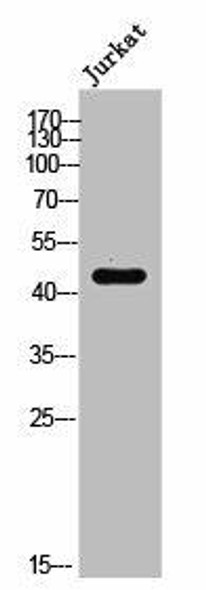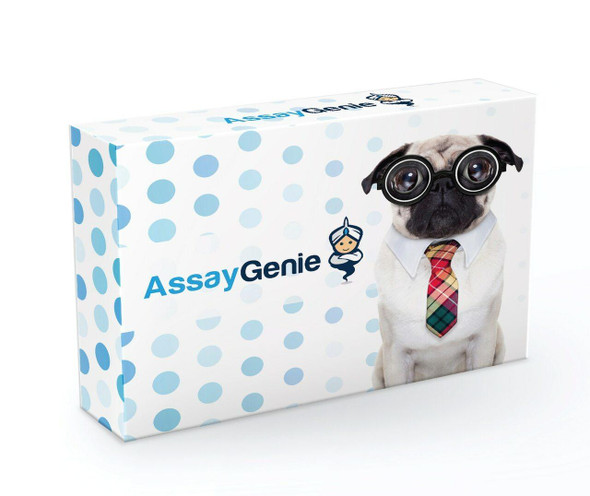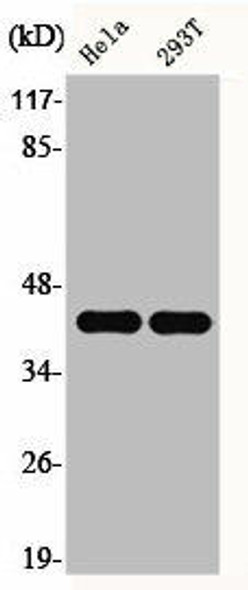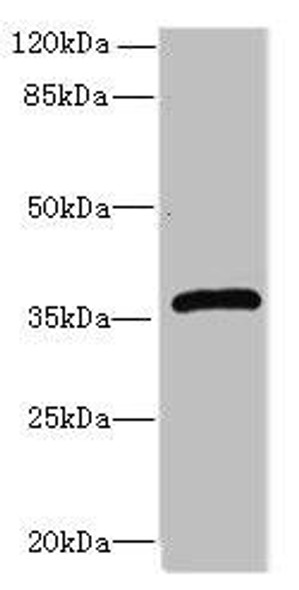Description
| Antibody Name: | Phospho-EFNB1/EFNB2/EFNB3 (Tyr324) Antibody (PACO24401) |
| Antibody SKU: | PACO24401 |
| Size: | 100ul |
| Host Species: | Rabbit |
| Tested Applications: | ELISA, WB, IHC |
| Recommended Dilutions: | ELISA:1:2000-1:10000, WB:1:500-1:1000, IHC:1:50-1:100 |
| Species Reactivity: | Human, Mouse, Rat |
| Immunogen: | Peptide sequence around phosphorylation site of tyrosine 324 (G-D-Y(p)-G-H) derived from Human Ephrin B1/B2/B3 . |
| Form: | Liquid |
| Storage Buffer: | Rabbit IgG in phosphate buffered saline (without Mg2+ and Ca2+), pH 7.4, 150mM NaCl, 0.02% sodium azide and 50% glycerol. |
| Purification Method: | Antibodies were produced by immunizing rabbits with synthetic phosphopeptide and KLH conjugates. Antibodies were purified by affinity-chromatography using epitope-specific phosphopeptide. Non-phospho specific antibodies were removed by chromatogramphy using non-phosphopeptide. |
| Clonality: | Polyclonal |
| Isotype: | IgG |
| Conjugate: | Non-conjugated |
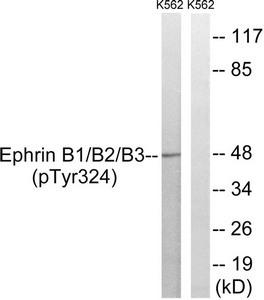 | Western blot analysis of extracts from K562 cells treated with serum using Ephrin B1/B2/B3 (Phospho-Tyr324) Antibody.The lane on the right is treated with the antigen-specific peptide. |
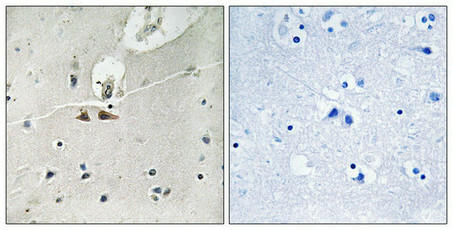 | Immunohistochemical analysis of paraffin-embedded human brain tissue using Ephrin B1/B2/B3 (Phospho-Tyr324) antibody (left)or the same antibody preincubated with blocking peptide (right). |
| Background: | This gene encodes a member of the ephrin family. The encoded protein is a type I membrane protein and a ligand of Eph-related receptor tyrosine kinases. It may play a role in cell adhesion and function in the development or maintenance of the nervous system. |
| Synonyms: | EPL2; CEL5-L; EFL-3; EFNB1; ELK-L |
| UniProt Protein Function: | EFNB1: a type I membrane protein of the ephrin family. A ligand of Eph-related receptor tyrosine kinases EphB1 and EphA1. Ephrins and ephrin receptors mediate numerous developmental processes, particularly in the nervous system. Ephrin-B1 may play a role in cell adhesion and functions in the development or maintenance of the nervous system. Binding to its receptor induces the collapse of commissural axons/growth cones in vitro. Induced by TNF-alpha. Expressed in brain, heart, placenta, lung, liver, skeletal muscle, kidney, and pancreas. |
| UniProt Protein Details: | Protein type:Membrane protein, integral; Ligand, receptor tyrosine kinase Chromosomal Location of Human Ortholog: Xq12 Cellular Component: integral to plasma membrane; cytoplasm; plasma membrane; synapse; nucleus; lipid raft Molecular Function:protein binding; ephrin receptor binding Biological Process: axon guidance; cell-cell signaling; ephrin receptor signaling pathway; positive regulation of T cell proliferation; cell adhesion; embryonic pattern specification; neural crest cell migration Disease: Craniofrontonasal Syndrome |
| NCBI Summary: | The protein encoded by this gene is a type I membrane protein and a ligand of Eph-related receptor tyrosine kinases. It may play a role in cell adhesion and function in the development or maintenance of the nervous system. [provided by RefSeq, Jul 2008] |
| UniProt Code: | P98172 |
| NCBI GenInfo Identifier: | 1706668 |
| NCBI Gene ID: | 1947 |
| NCBI Accession: | P98172.1 |
| UniProt Secondary Accession: | P98172,D3DVU0, |
| UniProt Related Accession: | P98172 |
| Molecular Weight: | 346 |
| NCBI Full Name: | Ephrin-B1 |
| NCBI Synonym Full Names: | ephrin-B1 |
| NCBI Official Symbol: | EFNB1 |
| NCBI Official Synonym Symbols: | CFND; CFNS; EFB1; EFL3; EPLG2; Elk-L; LERK2 |
| NCBI Protein Information: | ephrin-B1; EFL-3; LERK-2; ELK ligand; ligand of eph-related kinase 2; eph-related receptor tyrosine kinase ligand 2 |
| UniProt Protein Name: | Ephrin-B1 |
| UniProt Synonym Protein Names: | EFL-3; ELK ligand; ELK-L; EPH-related receptor tyrosine kinase ligand 2; LERK-2 |
| Protein Family: | Ephrin |
| UniProt Gene Name: | EFNB1 |
| UniProt Entry Name: | EFNB1_HUMAN |


